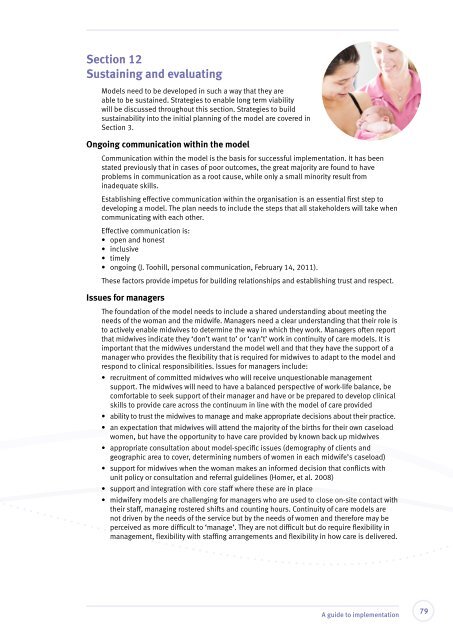Delivering continuity of midwifery care to Queensland women
Delivering continuity of midwifery care to Queensland women
Delivering continuity of midwifery care to Queensland women
Create successful ePaper yourself
Turn your PDF publications into a flip-book with our unique Google optimized e-Paper software.
Section 12<br />
Sustaining and evaluating<br />
Models need <strong>to</strong> be developed in such a way that they are<br />
able <strong>to</strong> be sustained. Strategies <strong>to</strong> enable long term viability<br />
will be discussed throughout this section. Strategies <strong>to</strong> build<br />
sustainability in<strong>to</strong> the initial planning <strong>of</strong> the model are covered in<br />
Section 3.<br />
Ongoing communication within the model<br />
Communication within the model is the basis for successful implementation. It has been<br />
stated previously that in cases <strong>of</strong> poor outcomes, the great majority are found <strong>to</strong> have<br />
problems in communication as a root cause, while only a small minority result from<br />
inadequate skills.<br />
Establishing effective communication within the organisation is an essential first step <strong>to</strong><br />
developing a model. The plan needs <strong>to</strong> include the steps that all stakeholders will take when<br />
communicating with each other.<br />
Effective communication is:<br />
• open and honest<br />
• inclusive<br />
• timely<br />
• ongoing (J. Toohill, personal communication, February 14, 2011).<br />
These fac<strong>to</strong>rs provide impetus for building relationships and establishing trust and respect.<br />
Issues for managers<br />
The foundation <strong>of</strong> the model needs <strong>to</strong> include a shared understanding about meeting the<br />
needs <strong>of</strong> the woman and the midwife. Managers need a clear understanding that their role is<br />
<strong>to</strong> actively enable midwives <strong>to</strong> determine the way in which they work. Managers <strong>of</strong>ten report<br />
that midwives indicate they ‘don’t want <strong>to</strong>’ or ‘can’t’ work in <strong>continuity</strong> <strong>of</strong> <strong>care</strong> models. It is<br />
important that the midwives understand the model well and that they have the support <strong>of</strong> a<br />
manager who provides the flexibility that is required for midwives <strong>to</strong> adapt <strong>to</strong> the model and<br />
respond <strong>to</strong> clinical responsibilities. Issues for managers include:<br />
• recruitment <strong>of</strong> committed midwives who will receive unquestionable management<br />
support. The midwives will need <strong>to</strong> have a balanced perspective <strong>of</strong> work-life balance, be<br />
comfortable <strong>to</strong> seek support <strong>of</strong> their manager and have or be prepared <strong>to</strong> develop clinical<br />
skills <strong>to</strong> provide <strong>care</strong> across the continuum in line with the model <strong>of</strong> <strong>care</strong> provided<br />
• ability <strong>to</strong> trust the midwives <strong>to</strong> manage and make appropriate decisions about their practice.<br />
• an expectation that midwives will attend the majority <strong>of</strong> the births for their own caseload<br />
<strong>women</strong>, but have the opportunity <strong>to</strong> have <strong>care</strong> provided by known back up midwives<br />
• appropriate consultation about model-specific issues (demography <strong>of</strong> clients and<br />
geographic area <strong>to</strong> cover, determining numbers <strong>of</strong> <strong>women</strong> in each midwife’s caseload)<br />
• support for midwives when the woman makes an informed decision that conflicts with<br />
unit policy or consultation and referral guidelines (Homer, et al. 2008)<br />
• support and integration with core staff where these are in place<br />
• <strong>midwifery</strong> models are challenging for managers who are used <strong>to</strong> close on-site contact with<br />
their staff, managing rostered shifts and counting hours. Continuity <strong>of</strong> <strong>care</strong> models are<br />
not driven by the needs <strong>of</strong> the service but by the needs <strong>of</strong> <strong>women</strong> and therefore may be<br />
perceived as more difficult <strong>to</strong> ‘manage’. They are not difficult but do require flexibility in<br />
management, flexibility with staffing arrangements and flexibility in how <strong>care</strong> is delivered.<br />
A guide <strong>to</strong> implementation<br />
79
















